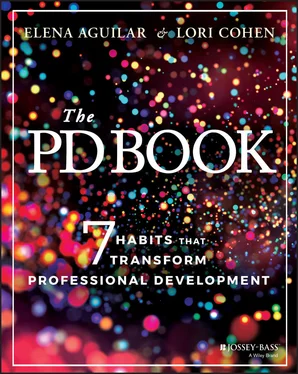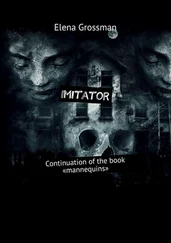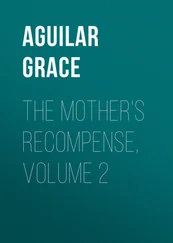Elena Aguilar - The PD Book
Здесь есть возможность читать онлайн «Elena Aguilar - The PD Book» — ознакомительный отрывок электронной книги совершенно бесплатно, а после прочтения отрывка купить полную версию. В некоторых случаях можно слушать аудио, скачать через торрент в формате fb2 и присутствует краткое содержание. Жанр: unrecognised, на английском языке. Описание произведения, (предисловие) а так же отзывы посетителей доступны на портале библиотеки ЛибКат.
- Название:The PD Book
- Автор:
- Жанр:
- Год:неизвестен
- ISBN:нет данных
- Рейтинг книги:5 / 5. Голосов: 1
-
Избранное:Добавить в избранное
- Отзывы:
-
Ваша оценка:
- 100
- 1
- 2
- 3
- 4
- 5
The PD Book: краткое содержание, описание и аннотация
Предлагаем к чтению аннотацию, описание, краткое содержание или предисловие (зависит от того, что написал сам автор книги «The PD Book»). Если вы не нашли необходимую информацию о книге — напишите в комментариях, мы постараемся отыскать её.
The PD Book,
The PD Book
The PD Book — читать онлайн ознакомительный отрывок
Ниже представлен текст книги, разбитый по страницам. Система сохранения места последней прочитанной страницы, позволяет с удобством читать онлайн бесплатно книгу «The PD Book», без необходимости каждый раз заново искать на чём Вы остановились. Поставьте закладку, и сможете в любой момент перейти на страницу, на которой закончили чтение.
Интервал:
Закладка:
Elena was flexible and responsive to requests. She made adjustments to the schedule based on feedback. When she observed that an activity needed more time, she had a set of criteria with which to make quick decisions.
Elena gave participants many choice points. For example, she said, “During this 90‐minute block, you can pick from four activities.” After explaining the options, she gave participants a chance to make thoughtful decisions and communicated confidence in the choice they made.
Elena modeled vulnerability, risk taking, and transparency. She shared her own emotions, including her enthusiasm for the community that she saw developing and the learning that was happening. She also modeled setting boundaries. For example, after one long afternoon, she said, “I'm feeling a little drained, which isn't a surprise given that I'm super introverted, so I'm going to take a walk alone and recharge. I'll see you all later!” This gave participants permission to take care of themselves, to share their emotions, and to take risks.
After Elena pulled back the curtain, participants recognized that they could have been in any configuration of a home group and they likely would have cultivated deep, authentic connections. The magic was not in the groupings, but in the design and facilitation of the learning experience and in the conditions that were created for the retreat.
Having peeked behind the curtain, participants also recognized that they could use the same tools and strategies that Elena had used to create transformative learning experiences for the folks they supported. Elena wanted them to be able to create for others what she'd given them—and in the feedback she's received in the years since this retreat happened, she knows that many of them have done so.

We can't wait to share our philosophy, habits, tips, and tricks for creating transformative professional development sessions like the one Elena facilitated. But we're going to take this step‐by‐step, and the next step is to ensure that we're aligned on some terminology, specifically on what we mean when we say professional development , a term that's used so broadly as to be almost meaningless. This book is called The PD Book , but what exactly is “professional development”?
Defining Professional Development
There have been far too many times when we have observed something that was called professional development, but we've thought, this is not PD. There's no learning going on in this room. The facilitator just wants participants to nod and accept his opinions and do what he says . When we have found ourselves in a faculty room or a conference hall watching educators grade papers in their laps during a professional development, we feel deflated. There's no learning going on in the room, and we can't blame the participants.
The term professional development (PD) can be used to mean a lot of different things from this kind of mindless training to sessions with the HR team about insurance options. Before you continue, take a moment to think about how you define professional development , how it's defined where you work, and, perhaps, what you wish PD meant.
The Definition
Let's start with naming the obvious elements of PD: It's a way that you continue developing your knowledge and abilities after you've met the baseline requirements for a position.
Many professions have expectations around ongoing development. You may need to renew a license or certificate in order to continue practicing in your field or you may need to develop additional skill sets to be promoted. In many organizations, there's also an assumption that the baseline may change: Although you're qualified when you're hired, you'll face new challenges and will need to continue developing skills. Whether you're in education or medicine or insurance law, we can count on the fact that changes in policy or demographics, advances in research and knowledge, or a shift in an organization's commitment will require continued learning. In schools, continued learning is required when a region experiences an influx of immigrants and teachers need to learn how to teach English learners, when new findings on the neuroscience of learning require that teachers acquire additional skills for teaching math, or when a school board adopts a resolution to create equitable schools.
We may also need to engage in professional development to refine a particular skill set. For example, the skills needed by positional leaders are extensive—whether they lead a school or a nonprofit. Even after leaders complete an administrative credential or get an MBA, they might need to further develop communication skills, emotional intelligence, or the ability to work across lines of difference. No one is ever done with their learning, and when learning happens in the context of a profession, it's called PD.
Refining the Definition
Can you recall a PD session you attended in which you felt, during the session or by the end of it, that you had changed? That you had new insights into yourself, your students, or your situation? That you had acquired new skills?
Can you recall another PD session that you attended where perhaps you felt ambivalent about in the moment but later the ideas from that session percolated into your mind? Maybe those ideas prompted you to try something different at work?
Elena recalls a slew of PD experiences as a teacher that resulted in her growth and development: a district‐wide August training for 300 third‐grade teachers on a new math curriculum during which she spent days exploring manipulatives and being a “student” as a master teacher demonstrated the lessons; a series of arts integration PD sessions in which Elena was given time to plan lessons and get feedback on how she had incorporated the arts; a two‐year teacher inquiry project in which Elena did action research in her classroom. Each of these learning experiences changed, and improved, what Elena did as a teacher.
In contrast, Elena also remembers other so‐called PD sessions that she was asked to attend, from which she walked away mumbling something like, “a total waste of time.”
We've all attended meetings that were called PD in which the facilitator clicked through a massive slide deck, shared too much background, disconnected data, and a few dictionary definitions, and gave mandates. We may have taken in the information and complied with the mandates, but there was no learning going on inside of us. Perhaps it appeared that our behavior changed—we did what we were told. But we did so out of compliance and fear of repercussions, not because we'd learned and grown. Those meetings, therefore, were not professional development.
Let's stop using the term PD when what happens doesn't involve learning.
PD Structures
Identifying the structures in which PD happens helps us home in on an understanding of PD. In schools, PD typically happens in the twice‐a‐month all‐staff PD meetings or on a Wednesday afternoon or during the two intensive days in August before school starts when the district convenes teachers for training on a new initiative. PD can also take other forms: When teachers who are part of a professional learning community (PLC) undertake an inquiry project together, that's PD. Instructional Rounds can also be PD. Individual and team coaching is PD. And PD can also take place via an online course, at a conference, or through a book study.
While any of these structures—and there are many more—can house PD, we don't know whether true PD is happening until we consider development . And here we get at the core of our definition of PD : The goal of PD is to change practice.
Читать дальшеИнтервал:
Закладка:
Похожие книги на «The PD Book»
Представляем Вашему вниманию похожие книги на «The PD Book» списком для выбора. Мы отобрали схожую по названию и смыслу литературу в надежде предоставить читателям больше вариантов отыскать новые, интересные, ещё непрочитанные произведения.
Обсуждение, отзывы о книге «The PD Book» и просто собственные мнения читателей. Оставьте ваши комментарии, напишите, что Вы думаете о произведении, его смысле или главных героях. Укажите что конкретно понравилось, а что нет, и почему Вы так считаете.












